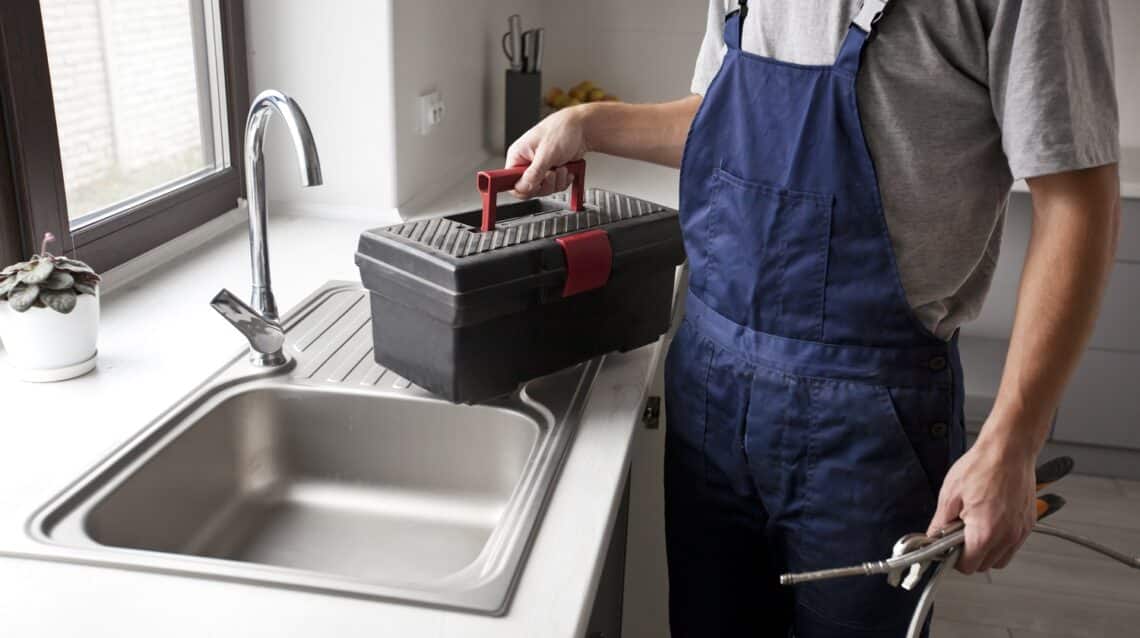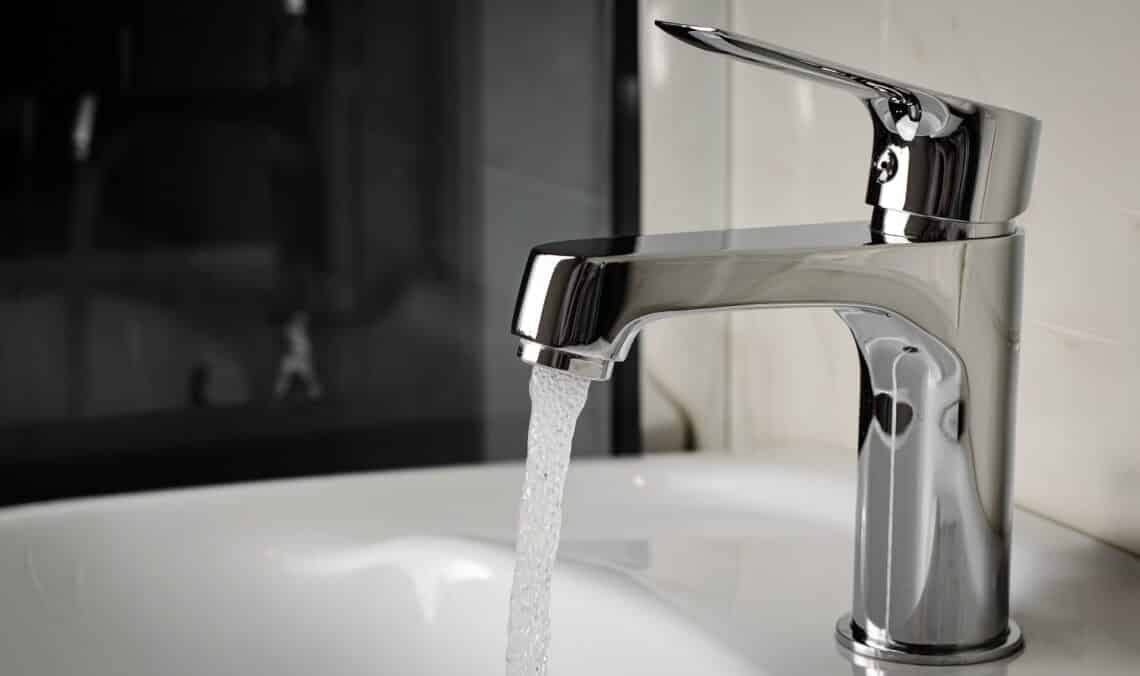A stuck faucet handle can be a real pain, but removing it should feel like a breeze if you follow the right technique.
Usually, such a situation occurs when you need to take off the handle for repairing the faucet valve. While it’s not a herculean task, sometimes when the faucet is too old or has been exposed to high humidity, corrosion can lead to jamming.
You can attempt loosening it using tools you have around the house, but you could risk ruining the finish. However, if it doesn’t budge, you could try one of our methods to pry it loose. For your convenience, we have explained each method by listing easy to follow steps.
But before we begin, let’s start with the things you’ll be needing.
Things Needed To Remove A Stuck Faucet

Besides a few tools, you’ll also need some materials that you can easily find in any departmental store. Following is a list of things that you should have.
- Flat-head screwdriver
- Wrench
- Hammer
- Penetrating oil
- Vinegar or scale dissolver
- 1/4th inch rubber tubing
- Small, stiff-bristle brush
- Dry rag
Important Note: Before you start with the task, make sure to turn off the water in your sink.
3 Methods To Remove A Stuck Faucet
While there is no universal method of taking off a faucet, we’ve discussed the 3 most common ways to deal with the situation.
Method 1- Remove Any Scale Or Lime Deposits
Scale or lime deposits are common on old faucet handles. The buildup develops over the years, and other minerals in water are likely a contributing factor. Usually, if you live in an area with hard water and do not have a water treatment system, these deposits accumulate rapidly and cause the handle to get stuck.
In fact, this buildup can occur even on handles made of stainless steel or other corrosion-resistant metal alloys. Typically, scales are light brown, while lime deposits are bright green in color. In comparison, mineral salts tend to leave a coarse and crusty residue. Nevertheless, it’s all too common, and a cinch resolve. Just follow these steps.
Step 1
Leverage a flat-head screwdriver to pry off the cap of the faucet handle. This will ensure easy access to the valve area, located within the handle.
Step 2
Take some white vinegar and pour it generously all over the handle. Make sure that the vinegar is not diluted with water. Don’t bother if it drips on to the sink or gets on other areas since it’s unlikely to harm any surface. However, if it helps, you can use a dry towel to cover the sink before pouring the vinegar.
To avoid making a mess, you can use a spray bottle to apply distilled vinegar on the open faucet cap and around the handle base. In case the nozzle cannot reach behind the handle, insert a 1/4-inch rubber tubing in the sprayer and point it precisely between the handle and the valve stem.
Step 3
Allow the vinegar coating to sit for about an hour. Meanwhile, the acid in the vinegar will gradually disintegrate and loosen the mineral deposits. After some time, you should be able to turn the handle.
Wait at least 30 minutes before giving it a wiggle. However, if it remains stuck, give it a few more hours and repeat from the top. Nevertheless, move on to the next hack if this method fails to produce any results.
Note: If you have an issue of scale or lime deposits, you may alternatively use store-bought scale dissolvers to get rid of the accumulation. You can use it in addition to the vinegar.
Method 2- Get Rid Of Any Corrosion
This may seem like a no-brainer, but corrosion on a metal unit can restrict movement, and eventually, your faucet handle can get stuck. That said, rust is a common issue with low-grade stainless steel and aluminum faucet parts.
If you use a water softener or have a water treatment system in place, the occurrence of mineral buildup is unlikely. In that case, corrosion could be the cause. So, simply undertake these steps, and you’re good to go.
Step 1
Use a flat-head screwdriver to pull off the faucet cap. You may also remove the screw underneath the cap to get a better look at the valve inside.
Step 2
If you find a crusty brownish-red layer inside the valve, it’s most likely rust. Now, use a small, stiff-bristle brush to scrape and clean the area as much as possible. Reach down inside the cavity and apply a digging and brushing motion for the best results.
While working, wipe off the particles and residue on the brush with a dry rag. Doing so will get rid of the rust, so your faucet can function properly.
Step 3
Try pulling the handle again. If it budges just a tiny bit, it may need a little more coaxing. Use the dry rag to get a good grip on the handle and turn. If that doesn’t work, try this last trick.
Method 3- Apply Oil And Force
Sometimes, even after the rust debris has been scraped off, the handle remains stuck in position due to corrosion. Long story short, your brush may not be able to reach the smaller interior parts of the faucet handle. The rust may have spread to those areas that are beyond your access.
If the first 2 methods failed, you’re probably dealing with a corroded faucet handle. While it’s possible to resolve this issue, be prepared to apply some elbow grease.
Step 1
Start by removing the faucet cap. As explained in the 2nd method, remove the rust layer inside the valve, and then take off the top screw.
Step 2
Apply generous amounts of penetrating oil inside the valve and around the handle. You may also use a sprayer with a narrow nozzle for precise application. Let the oil sit for a couple of minutes.
Step 3
After that, wrap a dry rag around the handle and try turning it. If it makes little to no movement, carefully use a hammer to tap the handle in the direction you want to turn it. Usually, it’s counterclockwise or towards the left.
Make sure to apply minimum pressure and aim correctly. While tapping with the hammer, avoid contact with the valve stem or other parts of the sink.
Step 4
If the hammering does not produce any results, the wrench becomes the last resort. However, do not attempt this if you’re not sure about your grip. Simply tighten the wrench around the faucet handle.
With steady yet gentle pressure, slowly turn the wrench in the right direction. This force, combined with the penetrating oil treatment, should coax the handle to turn. As soon as it twists a bit, take off the wrench, and loosen it with your hands.
Uncontrolled mechanical force could damage the faucet handle, so make sure to apply only enough pressure to move it.
Things To Know When Removing A Faucet Handle
- Be generous with white vinegar or penetrating oil
- Apply steady but gentle pressure while using a wrench
- Twist or push the handle in the direction you would for turning on the water
Things To Avoid
- Risking injury by trying to turn a stuck faucet handle by hand
- Applying excessive force while using the hammer or wrench
- Turning the tap in the opposite direction

Final Words
Replacing valves can be a frustrating affair if you have to deal with a stuck faucet and don’t know where to begin. But with this guide, we hope we could shed some light on how to go about the whole process.
More often than not, stuck handles are caused by rust, mineral buildup, or simply time. That said, if you’re going down the DIY route, always be gentle when using the tools and make sure that you have a strong and firm grip.
At the same time, don’t attempt to do something drastic that you’ve seen online. Whatever the reason might be for your faucet to get stuck, these methods will help you loosen it without causing damage to other parts.
On that note, we’d be taking your leave. Till next time, handle it with care!
Related Articles
13 Best Bathtub Faucets Right Now
13 Best Double Bowl Kitchen Sinks
Why Your Water Dispenser Might Leak & How to Fix It?
How Does a Touchless Faucet Work | Expert Talks
13 Best Commercial Kitchen Faucets Right Now
13 Best Kitchen Sink Faucets to Consider | Buyer’s Guide + Reviews
How to Repaint a Fireclay Farmhouse Kitchen Sink


